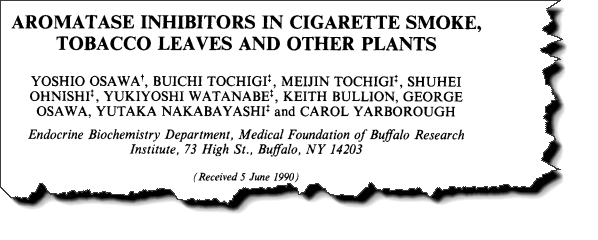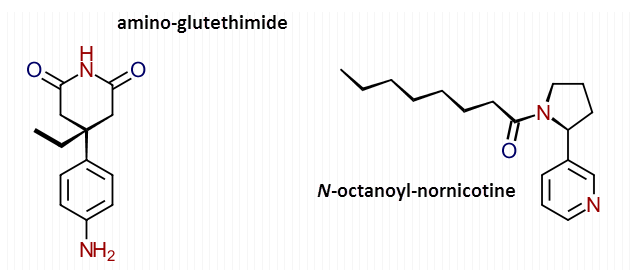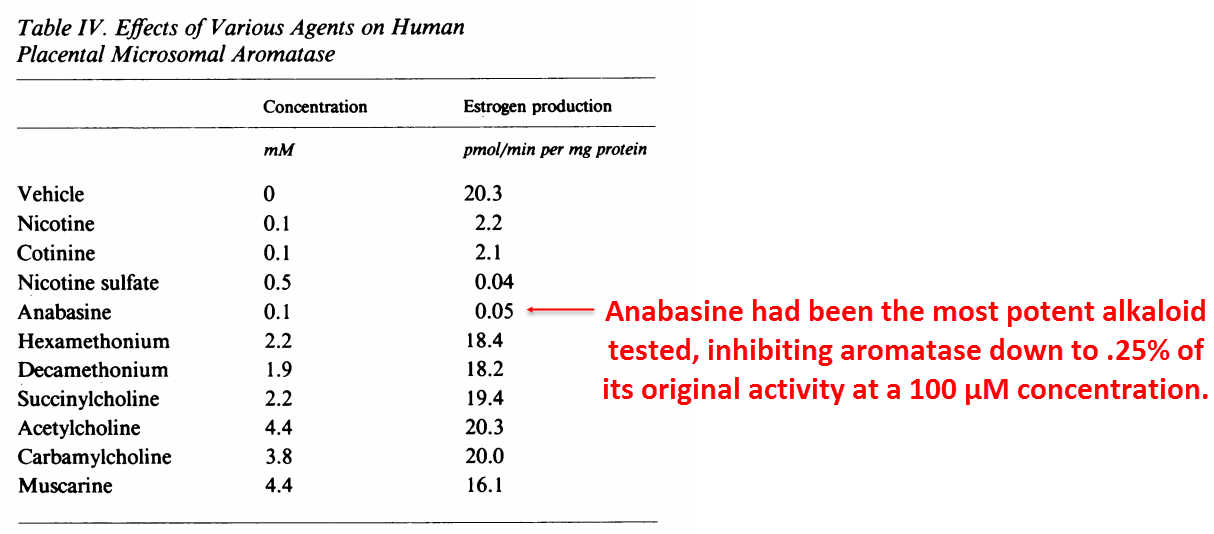
And how to use tobacco safely (without the carcinogens)

—-Important Message From Our Sponsor—-
Can any girl squirt?
Squirting is when fluid comes gushing out of a woman’s vagina, often accompanied by intense, full-body O’s.
And for her, it feels really, REALLY good.
But she can’t do it by herself…vibrators won’t hit the mark…
That’s one big reason she needs you and your jackhammer.
And few guys know how…
–> How to make a woman squirt (even if she thinks she can’t)

———-
Strange but true: proof that tobacco raises testosterone
Aromatase is the enzyme responsible for converting androgens into estrogen, two steroid classes so influential there’d be little difference in gender without it.
Testosterone in males normally outnumbers estrogens by about 30∶1, while the corresponding ratio in females is roughly 1∶9. Modifying these ratios will lead to differences in phenotype, notably of the breast and midsection.

This is because the estradiol receptor (ERα) translates the DNA needed for the prolactin receptor.
This is important, as prolactin is completely ineffectual without it.
Prolactin is a powerful growth hormone, yet only certain areas of the body express its receptor.
Knock-out studies on rats show they will live just fine without prolactin receptors, although with a much less feminine fat distribution.
Increased expression of aromatase leads to “’severe gynecomastia” in males, and low-functioning aromatase isoforms — representing 0.2% activity in this case — can lead to undetectable estradiol levels.
While low estrogen is perhaps unwelcome in females, having practically none translates into a deeper voice and taller stature in males:
‘His voice deepened at about 14 yr of age, and he started to shave regularly between 16-17 yr of age. […] He was 204.0 cm tall [6 feet, 8 inches] and weighed 135.1 kg. The arm span was 210.6 cm and the ratio of upper segment to lower segment was 0.84. Blood pressure was 158/72 mm Hg. He was well developed and nourished.’ ―Morishima
The increased height observed with low estradiol could be from a reduced expression of prolactin receptors, freeing membrane space for the similar growth hormone receptor.
Growth hormone, acting through its membrane receptor, is a classic height-promoting peptide.
Prolactin and growth hormone are both peptide hormones released by the pituitary gland, and so similar in form that geneticists are convinced prolactin had been an evolutionary spin-off of growth hormone.
Estrogen also has potentially dangerous metabolites.
After becoming 2-methoxyestradiol, estrogen inhibits microtubule elongation.
Microtubules are found in the center of every nerve and are the irreducible structure of the nervous system.
Myelin is often found around larger nerves, which insulates and protects them, yet some nerves are found unmyelinated and are just bundles of microtubules.
Thyroid hormone has been shown to stabilize microtubules, thereby promoting growth, while brain folate is necessary to synthesize the GTP needed for normal elongation.
Since microtubules are what transmit nervous impulses, it would appear reasonable to view microtubule remodeling as being inseparable from learning.
We need microtubules, and the microtubule depolymerizing treatment colchicine causes peripheral neuropathy and memory problems.
‘As noted above, nicotine, cotinine, and anabasine all inhibited estradiol accumulation in choriocarcinoma cells at micromolar concentrations.’ ―Barbieri
So there are a few good reasons to keep the androgen-to-estrogen ratio in the normal range, and perhaps even to increase it from the average of 30∶1 to around 40- or 50∶1.
In this way, males can avoid the female body shape by antagonizing prolactin and enhance learning and memory by promoting microtubule stability.
Aromatase is the one enzyme most responsible for determining the androgen-to-estrogen ratio.
This enzyme is a coveted treatment target for this reason, yet inhibiting it is a bit more difficult than you might imagine.
For instance, the 8-prenylnaringenin found in hops is a very powerful aromatase inhibitor with an IC50 of 65 nM.
Yet despite its potency, 8-prenylnaringenin also activates the estrogen receptor (ERα) in low nanomolar concentrations.
The net effect of hops is actually estrogenic, which is kind-of a downer for German pilsner fans — i.e. Beck’s, St. Pauli Girl, Pilsner Urquell — and absolutely disastrous news for IPA drinkers.

A similar thing can be said about apigenin, a flavonoid which modestly inhibits aromatase yet is also a weak estrogen.
The small concentrations of this found in food likely won’t do much at all, yet it’s estrogenic effects effectively anulls it’s antiestrogenic potential.
Yet the nicotine found in tobacco, and the anabasine, can inhibit aromatase without activating ERα.
This is an especially important function because smoking also increases androgens, with androstenedione and DHEA most strongly.
If tobacco didn’t also inhibit aromatase to a degree, then smoking could increase androgens and also its downstream estrogens.

Increasing androstenedione normally induces a corresponding increase in estrone, which is the other main aromatase product besides estradiol.
Although less active at the estrogen receptors, estrone does have the potential of being converted into estradiol by 17β-hydroxysteroid dehydrogenase.
For this reason it cannot be neglected simply as a “minor estrogen.”
‘Androstenedione in concentrations as low as 2nM resulted in the significant accumulation of estradiol.’ ―Barbieri
The ability of tobacco to increase androgens while at the same time inhibiting aromatase makes it a suitable way, and probably the most common one, to increase the androgen∶estrogen ratio.

Reports of this effect began appearing about 30 years ago, such as this one here which had resulted from a chance discovery:
These researchers had noticed that smoking in the lab had interfered with a highly sensitive aromatase assay they had been working on.
They had then instituted a “no smoking in lab” rule and carried-on, yet they were so puzzled by this effect that they eventually decided to investigate it.
‘In the process of developing a simple and sensitive method for routine assays of aromatase activity,’ we realized that a puff of cigarette smoke during pipetting greatly influenced the outcome of the experiment. By eliminating smoking in the laboratory area, we were able to carry the original project to completion. However, the nagging question of why tobacco smoke affected aromatase activity…’ ―Osawa
They then collected cigarette smoke using glassware, filters, and solvents and fractionated the extracts using common techniques.
They observed the highest anti-aromatase activity in the basic fraction, which contained only about 20 or so compounds. Upon chromatography and then mass spectrometry, they identified the most powerful aromatase inhibitor as being N-octanoyl-nornicotine.
This molecule is essentially just caprylic acid (8∶0) covalently-bound through nornicotine’s pyrrole nitrogen.
So based on current conventions of chemical nomenclature, it might just as well be called N-capryl-nornicotine.

Also found in tobacco smoke is nornicotine, which is simply nicotine without its N-methyl group.
Besides octanoyl-nornicotine there were other fatty acid conjugates found in the smoke with comparable potencies, so there is more than just one potent aromatase inhibitor in tobacco.
For this reason, the antiestrogenic effect of tobacco is best seen as a cumulative function of all nicotine and anabasine congeners, as well as their metabolites.
‘The aqueous and organic extracts of cigarette smoke demonstrated dose-dependent inhibition of placental aromatase with 50% inhibition at 0.25 and 0.07 cigarette equivalent. […] the acid fraction of tobacco leaf showed a dependency on premixing time which suggests an irreversible inactivation of aromatase.’ ―Osawa
Octanoyl-nornicotine appears to form through smoking because the green tobacco leaves are only mildly inhibitory, likely on account of nicotine and anabasine present.
And most importantly, octanoyl-nornicotine completely lacks any pro-estrogen effects, which they proved in two different ways:
(1) They gave N-octanoyl-nornicotine to rats and noted a 4-day delay of the normal estrus cycle.
(2) They also observed a twofold decrease in breast cancer incidence in a separate rodent group.
So unlike the aromatase inhibitor 8-prenylnaringenin in hops, and apigenin in dandelions, the alkaloids in tobacco smoke cannot activate ERα. If it were to do this, Doctor Osawa wouldn’t have observed the delay in the reproduction cycle nor the 45% reduction in breast cancer incidence.
Osawa then followed this study up with another publication on this nornicotine derivative, revealing that the inhibition constant (Ki) was on par with aminoglutethimide — a treatment designed explicitly to inhibit aromatase.
‘…we found that N-octanoyl nornicotine, a component of cigarette smoke, exhibited competitive inhibition with an apparent Ki of 0.65 μM. This is comparable to that of aminoglutethimide, the clinically-used non-steroidal aromatase inhibitor.’ ―Osawa
This says a lot, and confirms its potency while establishing it as a veritable aromatase inhibitor by anyone’s standards.
Aminoglutethimide and N-octanoyl-nornicotine are in fact quite similar, both containing two nitrogen heterocycles linked together and a carbonyl group:

Because aminoglutethimide had been withdrawn in 1966 due to side-effects, N-octanoyl nornicotine can be seen as superior both in terms of safety and availability.
Osawa had actually done toxicological studies on this compound and concluded that it was relatively safe with an LD50 of 367 mg⁄kg body weight
‘Given these functional similarities between aminoglutethimide and nicotine, it is of interest to note that nicotine, cotinine, anabasine, and aminoglutethimide all share substantial chemical structural similarities.’ ―Barbieri
Even though Osawa noticed this effect unintentionally, this phenomenon was in fact discovered before.
The very first article reporting an anti-aromatase activity in tobacco smoke appeared in print three years before, in 1987.
Besides giving confirmation of the effect, retrospectively, this study is very interesting besides:

Published three years earlier than Osawa’s article, Robert Barbieri and associates had shown inhibition with just: anabasine, nicotine, and cotinine.
Anabasine is also present in tobacco, and cotinine is the main nicotine metabolite.
Although not quite as potent as octanoyl-nornicotine, anabasine and nicotine exist in greater numbers and would act to potentiate with the more powerful fatty acid conjugates.
Aromatase inhibition by nicotine is dose-dependent, yet added to this would be the contribution from cotinine and the far more potent anabasine.
Moreover, the inhibition of aromatase reliably spares androstenedione by limiting its conversion to estrone, just as you might expect:

This also implies that whatever increases androstenedione ought to increase estradiol as well, which unfortunately has been well-supported by evidence.
Taking testosterone supplements, for instance, would be expected to slightly increase circulating estradiol concentrations through aromatase.
This antiestrogenic effect of smoking is doubly important because tobacco also increases DHEA and androstenedione. These two substrates of aromatase could potentially become estrogens under its action.
The fact that smoking doesn’t affect estrogens very much while considerably increasing androgens implies that it also inhibits aromatase.
So without even seeing proof that nicotine and its congeners do this — shown in at least four studies — the inhibition of aromatase is just what you’d expect from the clinical and epidemiological data.
‘The addition of nicotine to the choriocarcinoma cell cultures resulted in the inhibition of both estradiol and estrone accumulation and a corresponding increase in unmetabolized androstenedione.’ ―Barbieri
Anabasine, a less common tobacco alkaloid, was certainly the most effective tested.
Yet the effects of all the tobacco alkaloids together would of course compound, contributing towards the higher androgens and lower estrogens observed in smokers of both sexes.

Additional confirmation of this effect was published only nine years ago, where the binding of radiolabeled [11C]-vorozole — an aromatase ligand — in the brain was antagonized by nicotine in primates.
From this you could assume that nicotine had occupied the aromatase catalytic site in such a way as to prevent binding of [11C]-vorozole — just as the experimenters had assumed.
‘The size of the effect suggests that nicotine is capable of inhibiting the activity of aromatase in the primate brain.’ ―Biegon
Moreover, the 20% whole-brain aromatase inhibition in primates occurred while using plasma concentrations that are normally found in smokers.
This suggests that smokers would have less estradiol in their brains, and more androstenedione, which of course would have implications in psychology.
Tobacco alkaloids are certainly the most freely-available inhibitors of aromatase, and are even sold over-the-counter in most convenient stores.
However, ammonia-free tobacco can now be purchased online and ought to be safer.
Ammonia is commonly added to tobacco to increase nicotine volatility through increasing pH, which would of course be fine were it not for its subsequent conversion into nitric oxide upon smoking.
It has been proven that nitric oxide is a combustion product of ammonia, both of which are toxic in their own ways.
Adding ammonia to cigarettes has been a near-universal practice since the ’60s, and because of this I can only recommend unadulterated tobacco sold without.
‘Aqueous extracts of smoke inhibited androstenedione conversion to estradiol in a dose-dependent manner. 50% inhibition of aromatase was observed at a smoke extract dose between 1 and 5 μl (1 μl of aqueous smoke solution represents 0.1% of a cigarette equivalent).’ ―Barbieri
‘For controls, both the total and free testosterone levels were higher in smokers than nonsmokers.’ ―Dai
‘All of the hormones formed by the adrenal gland, DHEA, DHEAS, cortisol, and androstenedione, as well as total plasma testosterone, DHT, and SHBG were significantly higher in smokers than nonsmokers, with the differences being more pronounced when controlling for age and BMI.’ ―Field
‘Androstenedione levels were higher in smokers in both the cases and controls.’ ―Dai
‘Evidence to suggest that nicotine inhibition of estradiol accumulation was due to a highly specific mechanism includes the following observations: (a) No change in progesterone accumulation or cell number was observed at nicotine concentrations that produced 50% inhibition of estradiol accumulation; (b) The nicotine inhibition of estradiol accumulation was completely reversible by removing the nicotine from the culture medium; and (c) Supraphysiologic concentrations of androstenedione (73 μM) completely blocked the nicotine inhibition of estradiol accumulation.’ ―Barbieri
—-Important Message About Inhibiting Aromatase at Home—-
Try my free Tee Soup for the highest testosterone you’ve had in years

My Tee Soup is made from natural ingredients you can mix up in a minute or less, and it comes with these benefits for men:
- Potentially doubles or triples your natural testosterone — the ingredients in my Tee Soup work by blocking the conversion of testosterone into estrogen that happens as men age
- Helps lower estrogen levels — thanks to this, more of your testosterone is staying testosterone instead of getting turned into estrogen
- Replaces fat with muscle mass — more natural T means less belly fat and leaner, stronger muscles without even working out
- Often Improves rockiness — with more natural testosterone and less estrogen, erections often returns quickly and keeps improving
- Boosts bedroom performance — more T usually results in more stamina, meaning you can go for longer
- In many men this increases libido — my Tee Soup often gives men a huge boost in drive, returning the libido you once had as a teenager
- Increases gut motility in many men — this helps ensure estrogen leaves the body properly instead of piling up in the gut and causing problems
- Boosts metabolism, men report — when testosterone goes up this way, the mitochondria are more efficient, so you can burn fat faster no matter what you eat
- Protects the heart — high testosterone is good for the heart and can even naturally lower blood pressure
- Protects the prostate — high testosterone is also good for the prostate and can prevent inflammation that leads to cancer
- Makes you more attractive to young, beautiful women — women can sense men with high T and they are biologically more attracted to men with good, healthy testosterone levels and low estrogen
- Increases your confidence — when you’re living the high T life, you feel extremely confident in your own skin which girls love
Start enjoying all these benefits with my Tee Soup (takes 2 minutes)
———-
